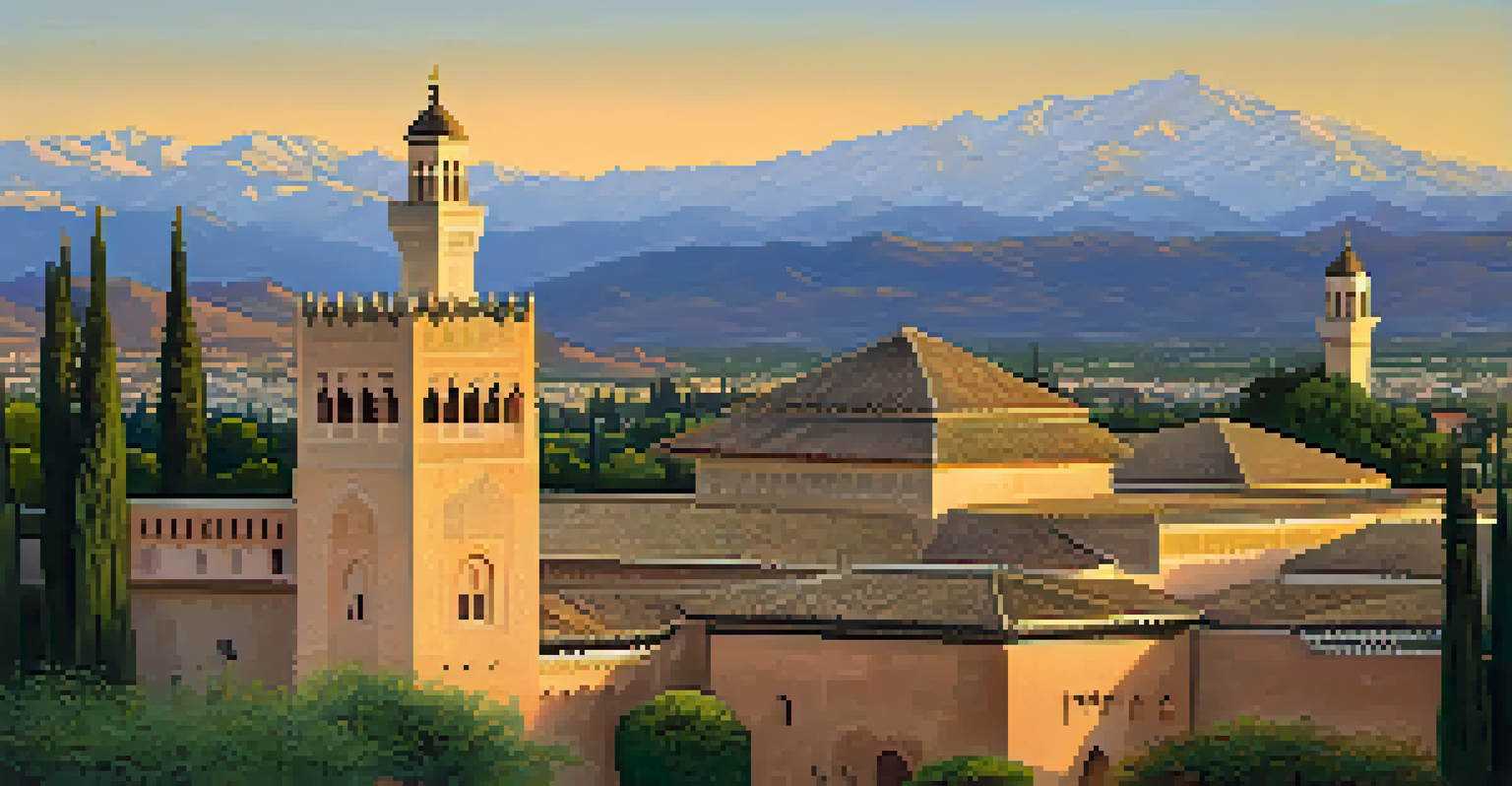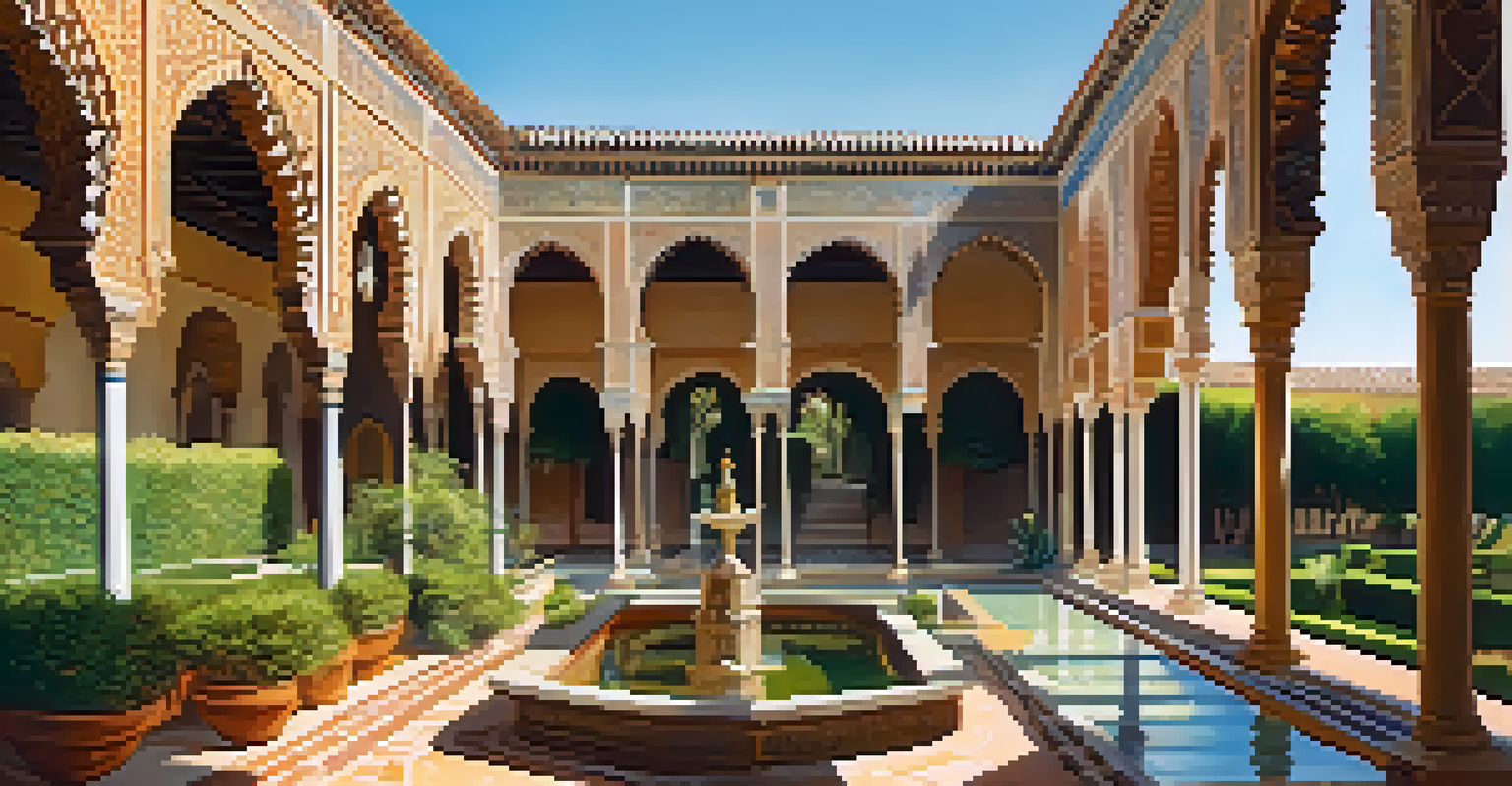Historical Palaces of Spain: A Glimpse into Royal Life

A Brief History of Spanish Royalty and Their Palaces
Spain's royal history is rich and complex, with monarchs who shaped the nation. From the Moors to the Habsburgs, each dynasty left an indelible mark on architecture and culture. This legacy is beautifully showcased in the palaces that still stand as testaments to their grandeur.
The beauty of the world lies in the diversity of its people.
The need for palatial residences arose from the desire for security, status, and splendor. These royal homes were not just living spaces; they were symbols of power and authority. Over the centuries, they have been the backdrop for significant historical events, from royal weddings to political intrigue.
Today, these historical palaces offer a glimpse into the lives of past royals, allowing us to appreciate the artistry and history embedded within their walls. Visiting these sites feels like stepping back in time, where every corner tells a story of elegance and ambition.
The Royal Palace of Madrid: A Modern Marvel
As the official residence of the Spanish royal family, the Royal Palace of Madrid is a stunning example of baroque architecture. With over 3,000 rooms, it boasts opulence that is hard to fathom. Each room is adorned with exquisite art, luxurious furnishings, and intricate details.

The palace is not just a residence; it also serves as a venue for state ceremonies and official functions. Its grand halls have hosted countless dignitaries and royal events, making it a hub of Spanish history and culture. Walking through its corridors, you can almost feel the echoes of history.
Spain's Royal Palaces Reflect History
The palaces of Spain serve as living museums, encapsulating the rich and diverse history of its monarchy through their architecture and cultural significance.
Visitors can explore the royal armory, the vast gardens, and even the royal pharmacy, which showcases the family's commitment to health and wellness. The Royal Palace of Madrid is more than just a beautiful building; it’s a living museum that invites you to connect with Spain's royal past.
Alhambra: The Jewel of Moorish Spain
Nestled in Granada, the Alhambra is a breathtaking fortress and palace complex that reflects Spain's Moorish heritage. Its intricate Islamic architecture, lush gardens, and stunning views of the Sierra Nevada mountains make it a UNESCO World Heritage site. The Alhambra is a true testament to the artistry of the Nasrid dynasty.
History is not a burden on the memory but an illumination of the soul.
Walking through the Alhambra feels like entering a fairy tale, with its ornate tilework, serene courtyards, and the sound of flowing water. The Nasrid Palaces within the complex showcase the sophisticated lifestyle of the Islamic royalty who once resided there. Each space is carefully designed to create a harmonious blend of beauty and functionality.
The Alhambra also serves as a symbol of cultural exchange, where Islamic and Christian influences intertwine. It stands as a reminder of a time when cultures coexisted, offering visitors a unique perspective on Spain's diverse history.
The Alcázar of Seville: A Blend of Cultures
The Alcázar of Seville is a stunning palace that reflects the rich tapestry of Spanish history. Originally a Moorish fort, it has evolved over centuries into a magnificent royal residence. Its intricate tilework, lush gardens, and impressive architecture capture the essence of both Islamic and Christian influences.
As one of the oldest active royal palaces in Europe, the Alcázar has hosted numerous monarchs and dignitaries. Its grand halls and chambers are filled with stories of love, betrayal, and political power. The palace's history is intricately linked to that of Seville, making it a vital piece of the city's cultural identity.
Alhambra Showcases Moorish Heritage
The Alhambra stands as a breathtaking example of Moorish architecture, highlighting the artistic achievements and cultural exchanges of the Nasrid dynasty.
Today, the Alcázar continues to inspire awe and admiration from visitors worldwide. Its enchanting beauty and historical significance make it a must-visit destination, allowing people to step into the shoes of royalty and experience the grandeur of the past.
Palacio Real de Aranjuez: A Royal Retreat
The Palacio Real de Aranjuez, located just outside Madrid, is a royal retreat known for its stunning gardens and serene atmosphere. This palace was a favorite summer residence for Spanish kings and queens, who sought respite from the hustle and bustle of court life. The lush gardens, filled with fountains and colorful flowers, create a tranquil escape.
The palace itself boasts a rich collection of art and historical artifacts, reflecting the tastes of various monarchs throughout history. Each room tells a story, from the opulent dining hall to the royal chambers adorned with intricate tapestries. It’s a place where the past feels alive, inviting visitors to immerse themselves in royal life.
As you stroll through the manicured gardens, you can almost imagine the conversations and celebrations that took place under the shade of its trees. The Palacio Real de Aranjuez is not just a palace; it's a testament to the beauty of nature and the elegance of royal living.
The Palace of Charles V: A Renaissance Marvel
The Palace of Charles V, located within the Alhambra complex, is a stunning example of Renaissance architecture in a predominantly Moorish setting. Built in the 16th century, it was commissioned by Charles V as a royal residence and a symbol of his power. Its circular courtyard and grand façade are strikingly different from the surrounding Islamic structures.
Despite its relatively small size compared to other palaces, the Palace of Charles V holds immense historical significance. It houses the Alhambra Museum, which showcases the rich history of the site and its cultural influences. The fusion of architectural styles within the palace tells a story of coexistence and adaptation.
Cultural Significance of Royal Sites
Spain's historical palaces are vibrant cultural centers today, offering insights into royal life and engaging visitors with their captivating stories and events.
Visitors are often captivated by the contrast between the Renaissance design and the Moorish elements of the Alhambra. This palace serves as a reminder of the diverse influences that shaped Spain, highlighting the beauty that emerges when different cultures blend together.
Exploring the Historical Palaces of Spain Today
Today, Spain's historical palaces are more than just remnants of the past; they are vibrant centers of culture and history. Many of these sites offer guided tours, educational programs, and cultural events that engage visitors of all ages. They provide a unique opportunity to learn about Spain’s royal heritage in an immersive way.
As you explore these palaces, you can gain insights into the daily lives of royals, their customs, and the historical context in which they lived. The stories of love, power, and resilience are woven into the very fabric of these buildings, making each visit a captivating experience.

Whether you're wandering through the gardens of the Alcázar or admiring the art in the Royal Palace of Madrid, each palace offers a window into a royal world that once was. These historical sites are essential to understanding Spain's rich cultural tapestry and the legacies that continue to influence the nation today.